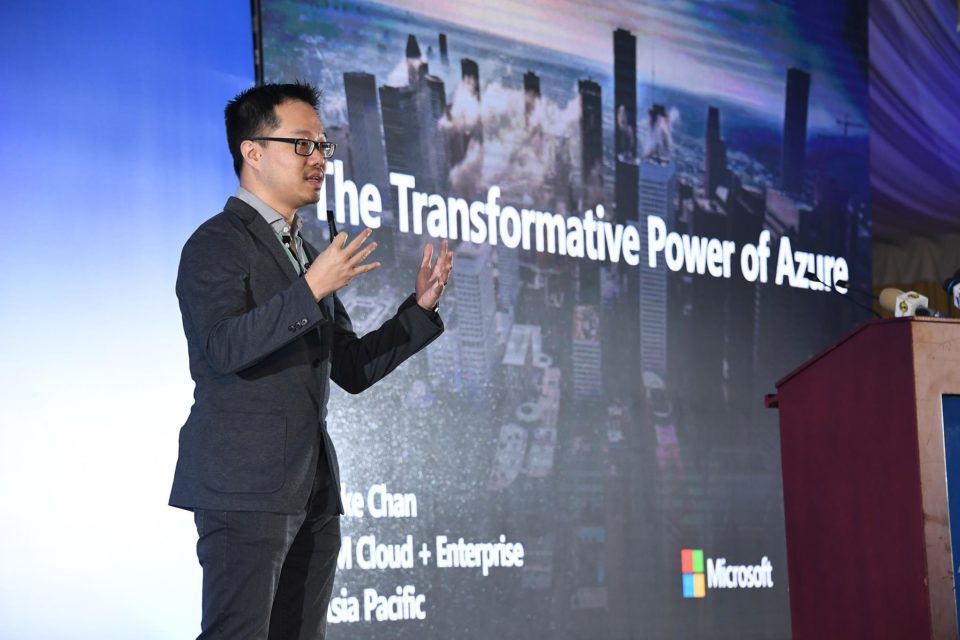 Mike Chan
Mike Chan
General Manager for Cloud and Enterprise,
Microsoft Asia Pacific
Mike Chan leads Microsoft’s Cloud and Enterprise efforts in Asia Pacific, where he helps companies and industries with their digital transformation journeys. While at the University of California, Los Angeles (UCLA), he was a co-founder of the Linux User Group and eventually went on to work at VA Linux, Intel, Trilogy and Sun Microsystems as a developer and consultant before joining Microsoft, 18 years ago.
1. Tell us about your journey to Microsoft?
My dad is an electrical engineer, and one day he brought home an AT&T computer. I think it was one of the first computers to have a hard drive and a color screen. Before AT&T, most people had to stick multiple floppy disks to run applications on a black and white screen. The AT&T had eight colors and I started playing this game called ‘War’ on it. I became extremely intrigued about how this thing worked.
Soon after, my family had a business reselling computer parts, and I started building my own machines. My interest continued through high school where we had to program our Texas Instruments calculators to help us solve math problems. I discovered that the program I created for quadratic equations spread across the entire school campus.
If only people paid me five dollars each at that time. I would have been set for life! You could say that’s where my interest in both hardware and software got started, and I realised I wanted to study computer science in college.
I worked at the UCLA Medical Center after leaving high school early to pursue my college ambitions. Soon after, I dropped out of college to work as a developer consultant – which saved me a lot of money on college tuition!
After my consulting and developer roles, I took on a role in marketing at Microsoft. That was 18 years ago, and I’ve never looked back. I’ve had strong mentors, coaches and sponsors who have helped diversity my experiences across product planning, pricing, licensing and partner functions, and international experiences.
2. If you were to build your own Artificial Intelligence program, what would it do?
I would build a travel adviser with artificial intelligence. I love to travel; and find myself spending a lot of time planning trips and creating OneNote pages for the places I want to visit. I know what I like, so I would like to reach a point where I can get a personalized itinerary based on all my interests, travel preferences and travel history, all with the click of a button. For example, knowing I like backpacking instead of a tour group holiday, the program would provide different options on flights, hotel rooms and package the deals to save time, along with restaurant recommendations and connected services.
Although I’d be giving my personal information in the form of preferences, I think it’s a fair trade-off that saves me hours planning. I’m proud of Microsoft for taking privacy seriously especially as it is applied to AI. I want to maintain control and transparency over how my data is used. Knowing that I can revoke that access if I no longer want the service means my privacy is being respected.
3. Tell us about your leadership style?
I respect Satya and his thought process about what leadership means. It is an individual’s responsibility of having a growth mindset and being able to admit failure while learning and acquiring knowledge. Satya talks about having clarity of the mission, generating energy within the team and delivering success as the essential formula for leadership. Even when you have clarity and energy within the team, there will be many roadblocks. It takes personal leadership to deliver that success, and sometimes that means doing things that aren’t your “day job.” I believe in the servant-leadership model as a form of personal leadership. Driving for success sometimes means being a bit challenging and asking for the fifth time, “I really need you to help me”, and never giving up that hope. Keeping the energy level high and maintaining grit through difficulty is required for success.
4. You can only take one item to work. What would you grab?
This question reminds me of a time when I was finishing up high tea with my wife in Florence, Italy while on vacation. Someone needed immediate approval for a purchase order (PO) and this one required an e-signature and an official approval in the system. Being on the other side of the planet without any work machine with me, you’d think that it was impossible, wouldn’t you?
We use DocuSign, powered by Microsoft Azure so once the system verified through two factor authentication since ‘Mike Chan’ was logging in from a location different from the usual workplace, it just took 30 seconds to sign and approve the document. My wife didn’t even notice the complex computing being carried out in front of her.
That’s what I appreciate about technology, and that’s how beautiful it is to operate in the cloud. And this is why I am so proud about where I work. Microsoft has enabled a secure work experience from any device to help empower people to do more from anywhere. This is the future of work.





